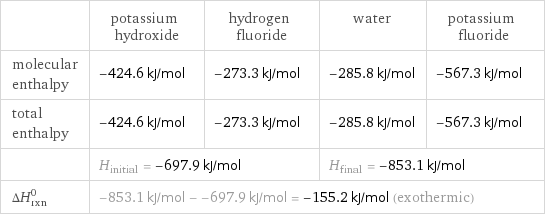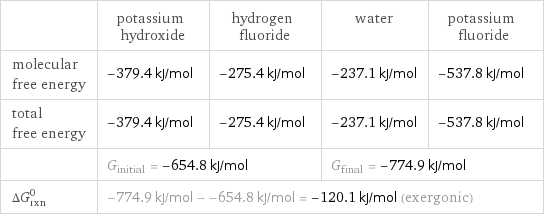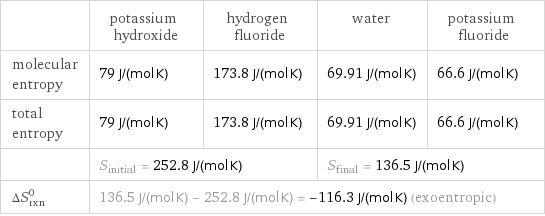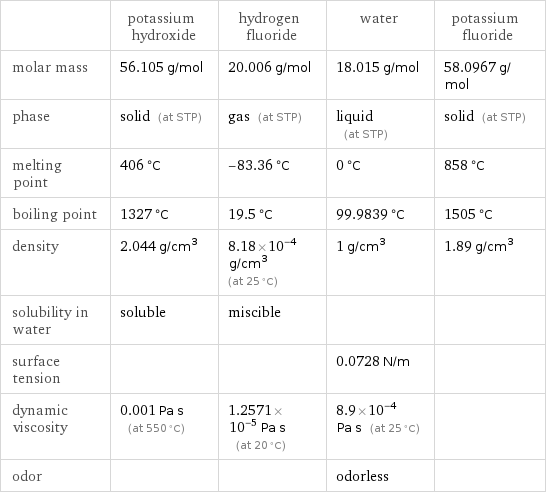Input interpretation

KOH potassium hydroxide + HF hydrogen fluoride ⟶ H_2O water + KF potassium fluoride
Balanced equation

Balance the chemical equation algebraically: KOH + HF ⟶ H_2O + KF Add stoichiometric coefficients, c_i, to the reactants and products: c_1 KOH + c_2 HF ⟶ c_3 H_2O + c_4 KF Set the number of atoms in the reactants equal to the number of atoms in the products for H, K, O and F: H: | c_1 + c_2 = 2 c_3 K: | c_1 = c_4 O: | c_1 = c_3 F: | c_2 = c_4 Since the coefficients are relative quantities and underdetermined, choose a coefficient to set arbitrarily. To keep the coefficients small, the arbitrary value is ordinarily one. For instance, set c_1 = 1 and solve the system of equations for the remaining coefficients: c_1 = 1 c_2 = 1 c_3 = 1 c_4 = 1 Substitute the coefficients into the chemical reaction to obtain the balanced equation: Answer: | | KOH + HF ⟶ H_2O + KF
Structures

+ ⟶ +
Names

potassium hydroxide + hydrogen fluoride ⟶ water + potassium fluoride
Reaction thermodynamics
Enthalpy

| potassium hydroxide | hydrogen fluoride | water | potassium fluoride molecular enthalpy | -424.6 kJ/mol | -273.3 kJ/mol | -285.8 kJ/mol | -567.3 kJ/mol total enthalpy | -424.6 kJ/mol | -273.3 kJ/mol | -285.8 kJ/mol | -567.3 kJ/mol | H_initial = -697.9 kJ/mol | | H_final = -853.1 kJ/mol | ΔH_rxn^0 | -853.1 kJ/mol - -697.9 kJ/mol = -155.2 kJ/mol (exothermic) | | |
Gibbs free energy

| potassium hydroxide | hydrogen fluoride | water | potassium fluoride molecular free energy | -379.4 kJ/mol | -275.4 kJ/mol | -237.1 kJ/mol | -537.8 kJ/mol total free energy | -379.4 kJ/mol | -275.4 kJ/mol | -237.1 kJ/mol | -537.8 kJ/mol | G_initial = -654.8 kJ/mol | | G_final = -774.9 kJ/mol | ΔG_rxn^0 | -774.9 kJ/mol - -654.8 kJ/mol = -120.1 kJ/mol (exergonic) | | |
Entropy

| potassium hydroxide | hydrogen fluoride | water | potassium fluoride molecular entropy | 79 J/(mol K) | 173.8 J/(mol K) | 69.91 J/(mol K) | 66.6 J/(mol K) total entropy | 79 J/(mol K) | 173.8 J/(mol K) | 69.91 J/(mol K) | 66.6 J/(mol K) | S_initial = 252.8 J/(mol K) | | S_final = 136.5 J/(mol K) | ΔS_rxn^0 | 136.5 J/(mol K) - 252.8 J/(mol K) = -116.3 J/(mol K) (exoentropic) | | |
Equilibrium constant
![Construct the equilibrium constant, K, expression for: KOH + HF ⟶ H_2O + KF Plan: • Balance the chemical equation. • Determine the stoichiometric numbers. • Assemble the activity expression for each chemical species. • Use the activity expressions to build the equilibrium constant expression. Write the balanced chemical equation: KOH + HF ⟶ H_2O + KF Assign stoichiometric numbers, ν_i, using the stoichiometric coefficients, c_i, from the balanced chemical equation in the following manner: ν_i = -c_i for reactants and ν_i = c_i for products: chemical species | c_i | ν_i KOH | 1 | -1 HF | 1 | -1 H_2O | 1 | 1 KF | 1 | 1 Assemble the activity expressions accounting for the state of matter and ν_i: chemical species | c_i | ν_i | activity expression KOH | 1 | -1 | ([KOH])^(-1) HF | 1 | -1 | ([HF])^(-1) H_2O | 1 | 1 | [H2O] KF | 1 | 1 | [KF] The equilibrium constant symbol in the concentration basis is: K_c Mulitply the activity expressions to arrive at the K_c expression: Answer: | | K_c = ([KOH])^(-1) ([HF])^(-1) [H2O] [KF] = ([H2O] [KF])/([KOH] [HF])](../image_source/61e50b5495b7d5f5520dfde80ea83061.png)
Construct the equilibrium constant, K, expression for: KOH + HF ⟶ H_2O + KF Plan: • Balance the chemical equation. • Determine the stoichiometric numbers. • Assemble the activity expression for each chemical species. • Use the activity expressions to build the equilibrium constant expression. Write the balanced chemical equation: KOH + HF ⟶ H_2O + KF Assign stoichiometric numbers, ν_i, using the stoichiometric coefficients, c_i, from the balanced chemical equation in the following manner: ν_i = -c_i for reactants and ν_i = c_i for products: chemical species | c_i | ν_i KOH | 1 | -1 HF | 1 | -1 H_2O | 1 | 1 KF | 1 | 1 Assemble the activity expressions accounting for the state of matter and ν_i: chemical species | c_i | ν_i | activity expression KOH | 1 | -1 | ([KOH])^(-1) HF | 1 | -1 | ([HF])^(-1) H_2O | 1 | 1 | [H2O] KF | 1 | 1 | [KF] The equilibrium constant symbol in the concentration basis is: K_c Mulitply the activity expressions to arrive at the K_c expression: Answer: | | K_c = ([KOH])^(-1) ([HF])^(-1) [H2O] [KF] = ([H2O] [KF])/([KOH] [HF])
Rate of reaction
![Construct the rate of reaction expression for: KOH + HF ⟶ H_2O + KF Plan: • Balance the chemical equation. • Determine the stoichiometric numbers. • Assemble the rate term for each chemical species. • Write the rate of reaction expression. Write the balanced chemical equation: KOH + HF ⟶ H_2O + KF Assign stoichiometric numbers, ν_i, using the stoichiometric coefficients, c_i, from the balanced chemical equation in the following manner: ν_i = -c_i for reactants and ν_i = c_i for products: chemical species | c_i | ν_i KOH | 1 | -1 HF | 1 | -1 H_2O | 1 | 1 KF | 1 | 1 The rate term for each chemical species, B_i, is 1/ν_i(Δ[B_i])/(Δt) where [B_i] is the amount concentration and t is time: chemical species | c_i | ν_i | rate term KOH | 1 | -1 | -(Δ[KOH])/(Δt) HF | 1 | -1 | -(Δ[HF])/(Δt) H_2O | 1 | 1 | (Δ[H2O])/(Δt) KF | 1 | 1 | (Δ[KF])/(Δt) (for infinitesimal rate of change, replace Δ with d) Set the rate terms equal to each other to arrive at the rate expression: Answer: | | rate = -(Δ[KOH])/(Δt) = -(Δ[HF])/(Δt) = (Δ[H2O])/(Δt) = (Δ[KF])/(Δt) (assuming constant volume and no accumulation of intermediates or side products)](../image_source/46022c2614de6762de58314613779427.png)
Construct the rate of reaction expression for: KOH + HF ⟶ H_2O + KF Plan: • Balance the chemical equation. • Determine the stoichiometric numbers. • Assemble the rate term for each chemical species. • Write the rate of reaction expression. Write the balanced chemical equation: KOH + HF ⟶ H_2O + KF Assign stoichiometric numbers, ν_i, using the stoichiometric coefficients, c_i, from the balanced chemical equation in the following manner: ν_i = -c_i for reactants and ν_i = c_i for products: chemical species | c_i | ν_i KOH | 1 | -1 HF | 1 | -1 H_2O | 1 | 1 KF | 1 | 1 The rate term for each chemical species, B_i, is 1/ν_i(Δ[B_i])/(Δt) where [B_i] is the amount concentration and t is time: chemical species | c_i | ν_i | rate term KOH | 1 | -1 | -(Δ[KOH])/(Δt) HF | 1 | -1 | -(Δ[HF])/(Δt) H_2O | 1 | 1 | (Δ[H2O])/(Δt) KF | 1 | 1 | (Δ[KF])/(Δt) (for infinitesimal rate of change, replace Δ with d) Set the rate terms equal to each other to arrive at the rate expression: Answer: | | rate = -(Δ[KOH])/(Δt) = -(Δ[HF])/(Δt) = (Δ[H2O])/(Δt) = (Δ[KF])/(Δt) (assuming constant volume and no accumulation of intermediates or side products)
Chemical names and formulas

| potassium hydroxide | hydrogen fluoride | water | potassium fluoride formula | KOH | HF | H_2O | KF Hill formula | HKO | FH | H_2O | FK name | potassium hydroxide | hydrogen fluoride | water | potassium fluoride
Substance properties

| potassium hydroxide | hydrogen fluoride | water | potassium fluoride molar mass | 56.105 g/mol | 20.006 g/mol | 18.015 g/mol | 58.0967 g/mol phase | solid (at STP) | gas (at STP) | liquid (at STP) | solid (at STP) melting point | 406 °C | -83.36 °C | 0 °C | 858 °C boiling point | 1327 °C | 19.5 °C | 99.9839 °C | 1505 °C density | 2.044 g/cm^3 | 8.18×10^-4 g/cm^3 (at 25 °C) | 1 g/cm^3 | 1.89 g/cm^3 solubility in water | soluble | miscible | | surface tension | | | 0.0728 N/m | dynamic viscosity | 0.001 Pa s (at 550 °C) | 1.2571×10^-5 Pa s (at 20 °C) | 8.9×10^-4 Pa s (at 25 °C) | odor | | | odorless |
Units
